Region Highland and Islands Plant badge Common heath | District Inner HebridesRoss Historic seat Finlaggan Castle | |
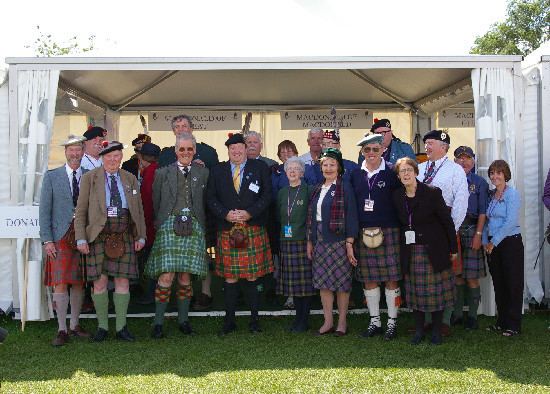 | ||
Motto per mare per terras (by sea and by land") War cry fraoch eilean (the heathery isle) | ||
The blood is strong it is no joy without clan donald
Clan Donald, also known as Clan MacDonald (Scottish Gaelic: Clann Dòmhnaill [ˈkʰl̪ˠãũn̪ˠ ˈdõː.ɪʎ])), is a Highland Scottish clan and one of the largest Scottish clans. The Lord Lyon King of Arms who is the Scottish official with responsibility for regulating heraldry in that country, issuing new grants of coats of arms, and serving as the judge of the Court of the Lord Lyon, recognizes under Scottish law the High Chief of Clan Donald. Historically the chiefs of the Clan Donald held the title of Lord of the Isles until 1493 and two of those chiefs also held the title of Earl of Ross until 1476.
Contents
- The blood is strong it is no joy without clan donald
- The lords of the isles clan donald c 1336 c 1545
- Origins
- Scottish Norwegian War
- Wars of Scottish Independence
- Succession to the Earldom of Ross
- Forfeiture of the Earldom of Ross and Lordship of the Isles
- 17th century and Civil War
- Jacobite rising of 1715
- Jacobite rising of 1745
- Chief
- Historic chiefs
- Castles
- Clan Donald castles
- Clan Donald branch castles
- References
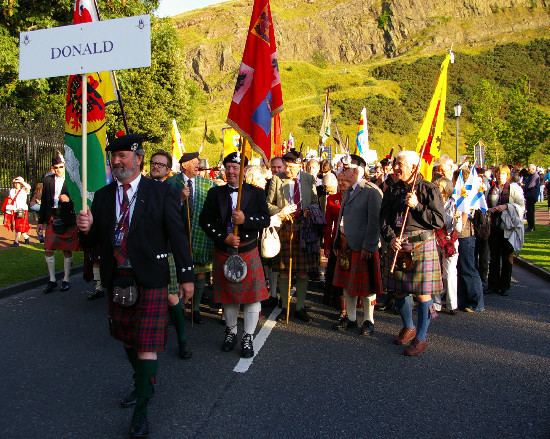
There are also numerous branches to the Clan Donald and several of these have chiefs recognised by the Lord Lyon King of Arms; these are: Clan Macdonald of Sleat, Clan Macdonald of Clanranald, Clan MacDonell of Glengarry, Clan MacDonald of Keppoch, and Clan MacAlister. There are also notable historic branches of Clan Donald without chiefs so-recognised, these are: the Clan MacDonald of Dunnyveg, Clan MacDonald of Lochalsh, the MacDonalds of Glencoe, and the MacDonalds of Ardnamurchan. The MacDonnells of Antrim are a cadet branch of the MacDonalds of Dunnyveg but do not belong to the Scottish associations and have a chief officially recognised in Ireland.
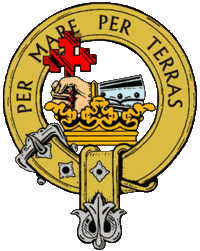
The lords of the isles clan donald c 1336 c 1545
Origins

The Norse-Gaelic Clan Donald traces its descent from Dòmhnall Mac Raghnuill (d. circa 1250), whose father Reginald or Ranald was styled "King of the Isles" and "Lord of Argyll and Kintyre". Ranald's father, Somerled was styled "King of the Hebrides", and was killed campaigning against Malcolm IV of Scotland at the Battle of Renfrew in 1164. Clan Donald shares a descent from Somerled with Clan MacDougall, who trace their lineage from his elder son, Dugall mac Somhairle. Their dynasties are together commonly referred to as the Clann Somhairle. Furthermore, they are descended maternally from both the House of Godred Crovan and the Earls of Orkney, through Somerled's wife Ragnhildis Ólafsdóttir, daughter of Olaf I Godredsson, King of Mann and the Isles and Ingeborg Haakonsdottir daughter of Haakon Paulsson, Earl of Orkney. It remains uncertain if the Clann Somhairle are also descendants in some manner, through one or another of the above dynasts, of the House of Ivar, but this is commonly argued.
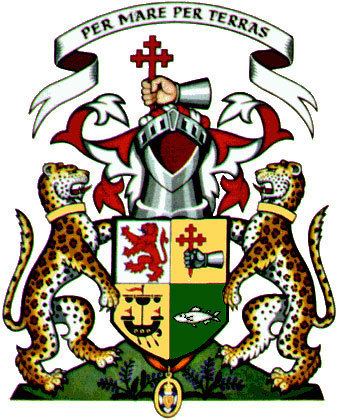
Tradition gave Somerled a Gaelic descent in the male line, as the medieval seanchaidhean (Gaelic historians) traced his lineage through a long line of ancestors back to the High Kings of Ireland, namely Colla Uais and Conn of the Hundred Battles. Thus Clan Donald claimed to be both Clann Cholla and Siol Chuinn (Children of Colla and Seed of Conn). Possibly the oldest piece of poetry attributed to the MacDonalds is a brosnachadh (an incitement to battle) which was said to have been written in 1411, on the day of the Battle of Harlaw. The first lines of the poem begin "A Chlanna Cuinn cuimhnichibh / Cruas an àm na h-iorghaile," (Ye children of Conn remember hardihood in the time of battle). A later poem made to John of Islay (1434–1503), last of the MacDonald Lords of the Isles, proclaims "Ceannas Ghàidheal do Chlainn Cholla, còir fhògradh," (The Headship of the Gael to the family of Colla, it is right to proclaim it), giving MacDonald's genealogy back to Colla Uais.
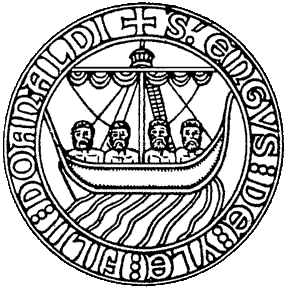
However a recent DNA study has shown that Somerled may have been of Norse descent in his male line. By testing the Y-DNA of males bearing the surnames MacDonald, MacDougall, MacAlister, and their variants it was found that a substantial proportion of men tested shared the same Y-DNA and a direct paternal ancestor. This distinct Y-chromosome R1a1 haplotype found in Scotland has been regarded as often showing Norse descent in the Britain and Ireland. According to the Clan Donald USA DNA Project about 22% of tested participants have this signature, most importantly including the chiefs, but despite the sensational claims it remains unclear whether Somerled himself was of paternal Norse ancestry. A non-paternity event remains a possible cause.
Scottish-Norwegian War
In 1263 Alexander III of Scotland defeated Haakon IV of Norway at the Battle of Largs. The Clan Donald chief, Aonghas Mor and his clan had technically been vassals of Haakon and so the king of Scots became their new overlord, as confirmed in the Treaty of Perth.
Wars of Scottish Independence
Aongus Mor's son was Aonghus Óg of Islay who supported Robert the Bruce at the Battle of Bannockburn in 1314. In recognition of Clan Donald's support King Robert the Bruce proclaimed that Clan Donald would always occupy the honoured position on the right wing of the Scottish army.
Succession to the Earldom of Ross
The title and territory of the Earl of Ross had originally been held by the Chief of Clan Ross but had passed through an heiress to the Leslie or Lesley family in the early 15th century. However, Angus Og's grandson, Donald of Islay, Lord of the Isles married Mariota, Countess of Ross (Margaret Lesley) who was the heiress of the Leslie Earls of Ross and he later claimed the position of Earl of Ross through this marriage. In 1411, Donald secured Dingwall Castle which was the principal seat of the Earldom of Ross, after he had defeated the powerful Clan Mackay who were supporters of the Stewart confederacy at the Battle of Dingwall. This in turn resulted in the indecisive Battle of Harlaw on 24 July 1411 fought between Donald of Islay's forces and those of Robert Stewart, Duke of Albany. There may have been as many as 10,000 men in the army of Donald at the Battle of Harlaw, but he failed to inflict a decisive victory and withdrew back to the Western Highlands. In the aftermath, Albany was able to retake Dingwall and seize control of Easter Ross. By 1415 the Earldom of Ross was with Murdoch Stewart, Duke of Albany. Donald prepared for war and proclaimed himself "Lord of Ross". However, the Duke of Albany appointed his own son John Stewart, 2nd Earl of Buchan as the new Earl of Ross.
In 1429 the Battle of Lochaber took place where forces led by Alexander of Islay, 3rd Lord of the Isles fought against the royalist army of James I of Scotland. Two years later the Battle of Inverlochy (1431) took place; While chief Alexander of Islay, Lord of the Isles was imprisoned by King James I, the Clan MacDonald were led by his nephew, Donald Balloch MacDonald, who defeated the Earl of Mar's royal army. The armies of the MacDonald Lords of the Isles were the only magnate forces in Scotland capable of inflicting defeats on the Crown at this time. The Battle of Inverlochy in 1431 is one example of this and the Battle of Lagebraad in Ross in 1480 is another.
Later in the 15th century the MacDonald chiefs would succeed as the Earls of Ross: firstly Alexander of Islay, Earl of Ross, son of Donald of Islay and Mariota, Countess of Ross, succeeded to the earldom as confirmed by a charter dated September 1437, following the assassination of James I of Scotland in February of the same year. Secondly, Alexander's son John of Islay, Earl of Ross who surrendered the earldom in 1475 to the King.
Forfeiture of the Earldom of Ross and Lordship of the Isles
In 1475, James III of Scotland forfeited the MacDonald Earldom of Ross and although the MacDonald Lordship of the Isles was not forfeited until 1493, in many ways 1475 marked the end of the lordship as a potent force. Following this is what the Books of Clanranald describe as a "great struggle for power among the Gael". Various leaders, such as Aonghas Óg who was the fourth illegitimate son of the Lord of the Isles, along with his son, Domhnall Dubh, and also Alexander MacDonald of Lochalsh and John Mor MacDonald of Dunyvaig were seeking to restore the MacDonald hegemony in the west. The Battle of Bloody Bay took place in 1480 where John MacDonald of Islay, Lord of the Isles and chief of Clan Donald was defeated by his son Aonghas Óg. The Battle of Skibo and Strathfleet took place in 1480 where John MacDonald of Islay, Lord of the Isles invaded Sutherland but was defeated by the Earl of Sutherland and the Clan Sutherland. Aonghas Óg's son Domhnall Dubh rebelled against James IV of Scotland and made an alliance with Edward VI of England in an attempt to regain the Lordship of the Isles and although various attempts were made to restore the lordship, by 1545 all had failed. The ultimate victors were the Crown's hard men in the north and west: Alexander Gordon, 3rd Earl of Huntly (chief of Clan Gordon), Archibald Campbell, 2nd Earl of Argyll (chief of Clan Campbell) and John MacIain of Ardnamurchan. The various branches of the Clan Donald began accepting charters from the Crown in recognition of their separate holdings. This was part of a royal policy that successfully kept the Clan Donald divided, and in doing so they were less of a threat to the central authority.
17th century and Civil War
In 1642 on Rathlin Island, during the Irish Rebellion, Covenanter soldiers of the Clan Campbell who formed Argyll's Foot were encouraged by their commanding officer Sir Duncan Campbell of Auchinbreck to kill the local Catholic MacDonalds. This they did with ruthless efficiency throwing scores of MacDonald women over cliffs to their deaths on rocks below.
Scotland in the Wars of the Three Kingdoms of 1644–47, was in large part a clan war between the MacDonalds and Clan Campbell. The MacDonalds sided with the Royalists in the English Civil War and the Irish Confederate Catholics in the Wars of the Three Kingdoms. The Campbells sided with the Scottish Covenanters. A MacDonald clansman, Alasdair Mac Colla raised an Irish force in 1644 and landed in Scotland, with the aim of linking up with the Scottish Royalists and taking back the lands that Clan Donald had lost to the Campbells. After a year of campaigning around Scotland, in which Mac Colla's men ravaged the Campbell lands, the two sides met at the Battle of Inverlochy (1645). Through cunning tactics the Royalist force of James Graham, 1st Marquess of Montrose, which included the MacDonalds under Alasdair Mac Colla, defeated the Scottish Covenanter forces led by Archibald Campbell, 1st Marquess of Argyll.
The Massacre of Glencoe took place in 1692, 38 unarmed MacDonalds from the Clan MacDonald of Glencoe were murdered when an initiative to suppress Jacobitism was entangled in the long running feud between Clan MacDonald and Clan Campbell, and MacIain who was the chief of the MacDonalds of Glencoe, was late in signing an oath of allegiance to William III of England.
Jacobite rising of 1715
During the Jacobite rising of 1715 the MacDonalds supported the Jacobite cause of the House of Stuart. Men of Clan MacDonald of Keppoch, and the Clan Macdonald of Clanranald fought at the Battle of Sheriffmuir on 13 November 1715 where chief Allan MacDonald of Clanranald was killed. The Clan MacDonald of Glencoe also fought at Sherriffmuir.
Jacobite rising of 1745
During the Jacobite rising of 1745 the Clan MacDonell of Glengarry along with the Clan MacDonald of Keppoch and the MacDonalds of Glencoe fought as Jacobites at the Battle of Prestonpans on 21 September 1745.
The Clan MacDonald of Clan Ranald, along with the Clan MacDonald of Glengarry, and Clan MacDonald of Keppoch, fought as Jacobites at the Battle of Falkirk Muir on 17 January 1746
The Clan MacDonald of Glencoe, Clan MacDonald of Clanranald, and Clan MacDonell of Glengarry, fought as Jacobites at the Battle of Culloden in April 1746, as did the Clan MacDonald of Keppoch whose chief, Alexander MacDonald of Keppoch, was killed.
The Clan MacDonald of Sleat branch had fought for the Jacobites in the 1715 rebellion, however they actually formed two battalions (Independent Highland Companies) in support of the British Government during the 1745 rebellion and as a result the Sleat possessions remained intact. However, according to A and A MacDonald these two companies were more of a hindrance than help to the Government as they were made up of officers and men who were in entire sympathy with the Jacobite Prince Charles Edward Stuart.
Chief
In 1947, the Lord Lyon King of Arms granted the undifferenced arms of Macdonald to Alexander Godfrey Macdonald, 7th Lord Macdonald, making him the first High Chief of Clan Donald. After his death in 1970, he was succeeded by his son Godfrey James Macdonald of Macdonald, 8th Lord Macdonald, who is the current high chief of Clan Donald. In 1972, the Macdonald estates were sold off to pay death duties. Lord Macdonald lives at Kinloch Lodge on Skye with his wife, the food writer Claire Macdonald (m. 1969).
Historic chiefs
The following is a list of some of the early chiefs of Clan Donald.
Castles
Over the centuries MacDonald castles have included:
